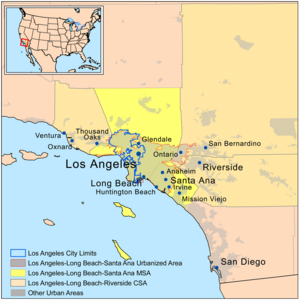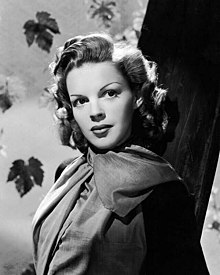The Greater Los Angeles Portal Greater Los Angeles is the most populous metropolitan area in the U.S. state of California, encompassing five counties in Southern California extending from Ventura County in the west to San Bernardino County and Riverside County in the east, with Los Angeles County in the center, and Orange County to the southeast. The Los Angeles–Anaheim–Riverside combined statistical area (CSA) covers 33,954 square miles (87,940 km2), making it the largest metropolitan region in the United States by land area. The contiguous urban area is 2,281 square miles (5,910 km2), whereas the remainder mostly consists of mountain and desert areas. With a population of 18.4 million in 2024, it is the second-largest metropolitan area in the country, behind New York, as well as one of the largest megacities in the world. In addition to being the nexus of the global entertainment industry, including films, television, and recorded music, Greater Los Angeles is also an important center of international trade, education, media, business, tourism, technology, and sports. It is the third-largest metropolitan area by nominal GDP in the world with an economy exceeding $1 trillion in output, behind New York City and Tokyo. There are three contiguous component urban areas in Greater Los Angeles: the Inland Empire, which can be broadly defined as Riverside and San Bernardino counties; the Ventura/Oxnard metropolitan area (Ventura County); and the Los Angeles metropolitan area (also known as Metropolitan Los Angeles or Metro LA) consisting of Los Angeles and Orange counties only. The Census Bureau designates the latter as the Los Angeles–Long Beach–Anaheim metropolitan statistical area (MSA), the fourth largest metropolitan area in the western hemisphere and the second-largest metropolitan area in the United States, by population of 13 million as of the 2020 U.S. census. It has a total area of 4,850 square miles (12,561 km2). Although San Diego–Tijuana borders the Greater Los Angeles area at San Clemente and Temecula, it is not part of it as the two urban areas are not geographically contiguous due to the presence of Camp Pendleton. However, both form part of the Southern California Megalopolis which extends into Tijuana, Baja California, Mexico. Throughout the 20th century, Greater Los Angeles was one of the fastest-growing regions in the United States, but growth has slowed since 2000. (Full article...) Selected article - Arrested Development is an American television sitcom created by Mitchell Hurwitz, which originally aired on Fox for three seasons from November 2, 2003 to February 10, 2006. A fourth season of 15 episodes was released on Netflix on May 26, 2013. The show follows the fictitious Bluth family, a formerly wealthy and habitually dysfunctional family, and is presented in a continuous format, incorporating handheld camera work, narration, archival photos, and historical footage. Ron Howard serves as an executive producer and the series' uncredited narrator. Set in Newport Beach, California, Arrested Development is filmed primarily in Culver City and Marina del Rey. Since its debut in 2003, the series has received widespread critical acclaim, six Primetime Emmy Awards, and one Golden Globe Award, and has attracted a cult following, including several fan-based websites. In 2007, Time listed it among the magazine's "All-TIME 100 TV Shows". In 2008, the show was ranked 16th on Entertainment Weekly's "New TV Classics" list. In 2011, IGN named Arrested Development the "funniest show of all time". Did You Know -
July 2014 Selected image Woman aircraft worker, Vega Aircraft Corporation, Burbank, World War II (1942) image credit: Library of Congress
WikiProject
Related PortalsSelected biography -Judy Garland (born Frances Ethel Gumm; June 10, 1922 – June 22, 1969) was an American actress, singer, and dancer. She attained international stardom and critical acclaim as an actress in both musical and dramatic roles, as a recording artist, and on the concert stage. Renowned for her versatility, she received a Golden Globe Award, a Special Tony Award and was one of twelve people in history to receive an Academy Juvenile Award. Garland began performing as a child, with her two elder sisters, in a vaudeville group, The Gumm Sisters, and was signed to Metro-Goldwyn-Mayer as a teenager. She appeared in more than two dozen films for MGM, including The Wizard of Oz (1939), Meet Me in St. Louis (1944), The Harvey Girls (1946), Easter Parade (1948), and Summer Stock (1950). Garland was a frequent on-screen partner of both Mickey Rooney and Gene Kelly, and regularly collaborated with director Vincente Minnelli, her second husband. In 1950, after 15 years with MGM, she was released from her contract with the studio amid a series of personal struggles that prevented her from fulfilling the terms of her contract. (Full article...)Regions, major cities and districtsRegions
Cities
Cities by countyTopicsCategoriesSelect [►] to view subcategories
Greater Los Angeles
Los Angeles County, California
Orange County, California
Ventura County, California
WikimediaThe following Wikimedia Foundation sister projects provide more on this subject:
Discover Wikipedia using portals |








































